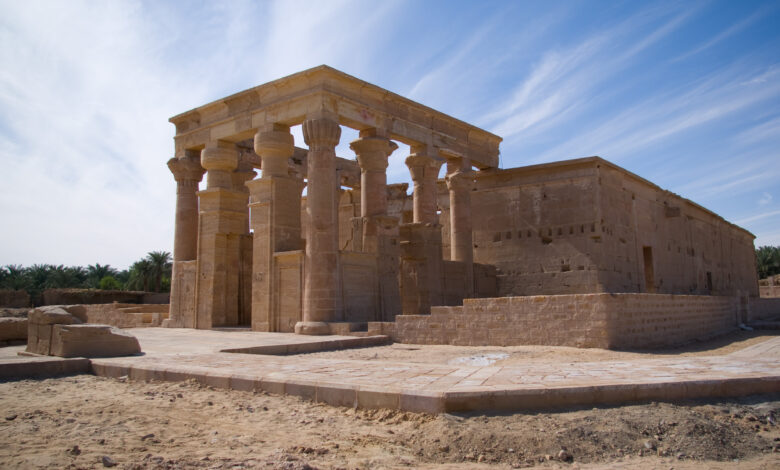
The city of Kharga serves as an ideal city for eco-tourism, as it enjoys beautiful natural elements such as sand dunes, in addition to hotels and tourist facilities made from distinctive building materials, alongside rooftop cultivation.
It is located 232 km southwest of Assiut, the capital of the New Valley Governorate. It was known in the past as the Great Oasis, as it occupies a large depression in the desert.
The city is host to a variety archaeological sites from different eras, including six sites open for visits and a museum.
These include:
The Temple of Hibis
Built from sandstone, this temple was believed to have been founded during the reign of kings Psamtik II and Apries, with its construction and inscriptions completed by King Darius I.
The temple was dedicated to the worship of the outlawed trinity “Amon, Mut and Khonsu” and the General Trinity “Osiris, Horus and Isis.” It consists of a marina, a Roman gate, the road of sphinxes, a Ptolemaic gate, a Persian gate, the pillared hall, the transverse hall, the hall of the Holy of Holies, and the Holy of Holies.
The temple was opened to the public in 2015 after the completion of restoration work.
Nadura Temple
Located three km north of Kharga, on a high hill that rises about 75 meters above the ground.
The name Nadura came as it was used as a control point for caravans passing by in antiquity on the Darb al-Arbaeen.
The temple was dedicated to the worship of the god Khonsu, and was built during the reign of Emperors Hadrian and Anthony Pius of the Roman era.
It consists of a sandstone building surrounded by brick walls.
Ghweita Temple
A sandstone building surrounded by brick walls, dedicated to the worship of “Amun, Mut and Khonsu.”
It consists of three halls that end with the shrine of the Holy of Holies, which belongs to the 27th Dynasty.
The rest of the temple dates back to the Ptolemaic era.
Qasr al-Zayyan Temple
It was built in 138 AD in the third year of the reign of the Roman Emperor Anthony Pius to worship the god Amun Hebat, the master of the city of Kharga in ancient Egyptian times.
Temple of Dush:
A sandstone building surrounded by a brick wall and a four-story castle. It was built during the reign of the Roman emperors Domitian, Trajan and Hadrian, and was dedicated to the worship of the Holy Trinity “Sarapis, Isis and Harpocrates.”
Al-Bagawat cemetery:
It dates back to between the second and seventh centuries AD, located six km north of the city of Kharga.
Bagawat was the main cemetery in Kharga during ancient Egyptian times and continued until the Coptic period.
The Bagawat cemetery consists of 263 shrines of different and distinctive architectural styles, with a skillful fresco depiction of Biblical figures on its ceilings.
New Valley Museum:
It is built on an area of 3150 square meters, and consists of a three-story building, containing 4,087 artifacts between exhibits and storage, dating from the beginning of the prehistoric era until the era of the Muhammad Ali family.




